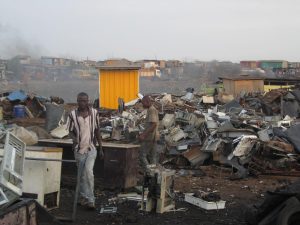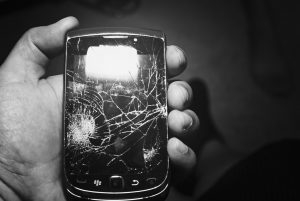In 2013, research showed that 87% of Canadians owned a cellphone. Did you know that while most cellphones can have a lifespan of 5 years, we use them on average for only 18 months? Given that there are 30 million cellphones in Canada, and about 4 BILLION in the world, it’s time we started thinking about the impact that these admittedly handy devices have on our lives, our planet, and the people who make and sell them.
What’s the Problem?
We could write a whole other blog on this (in fact, we already have, and will post it in due time!), but here’s a brief overview.
Social Problems

E-waste in Agbogbloshie, Ghana, where it is processed with no labour or environmental regulations
There are serious concerns with both the extraction of the minerals and metals used to make cellphones, and the working conditions of the manufacturing workers. The extraction process in many cases contributes to funding wars, and is in several places done by slaves in bonded labour. Those who manufacture cellphones often also face deplorable conditions, with factories seeing high suicide rates, massive amounts of unpaid forced overtime, and lack of compensation for injury on the job.
Environmental Problems
As with most non-renewable resources, the minerals that go into cellphones (especially coltan, more properly known as columbite-tantalite) have to be mined. Unfortunately some of the richest coltan deposits in the world are in national parks in the Congo, meaning that mining leads to deforestation and contributes towards the endangered status of the gorilla. Other minerals and metals have similar problems. Second, manufacturing cellphones has a carbon footprint to consider: each phone produced emits 16 kg of CO2, with another 50-1000 kg estimated CO2 emissions each year of use. Finally, disposing of cellphones can be problematic. If thrown into landfills, they can produce toxic leachate that ends up in our groundwater. Irresponsible recycling can lead to these used electronics being sent to places like Guangzhou, China, where plastics are often melted in open-air fires, leading to both pollution of air and water, and serious health problems among workers and residents.
The Solutions
We don’t have any easy answers to how cellphones can be made in more sustainable ways that are healthier for both people and the planet, but the new FairPhone (currently only available in Europe) is trying to put some lofty goals into practice. By using the principles of reduce, reuse, and recycle, you can personally have a big impact!
Reduce
- Go big or go home? Don’t buy a cellphone, or choose a flip phone over a smartphone! Living in radical simplicity may just change your life
- Extend the lifespan of your phone
- To extend the data storage life – aka keep your phone from slowing down, you can:
- Clear out unused apps frequently
- Back up your data onto an external source
- Clear your cache regularly
- Turn your phone off at least once a week
- Run an antivirus program
- Update your phone’s software…but stop doing it after about two generations have passed
- To maintain your battery capacity, some easy steps:
- Good charging hygiene: don’t let your phone battery drain before recharging. You’ll get more full-charge equivalents if you boost it by small amounts throughout the day (e.g. recharge at 75%, not 25%). And don’t let the battery die completely if you can help it!
- Try the apps coconutBattery (iPhone with Mac computer), or Battery by MacroPinch (Android) to check how many charges your battery has left
- Got a grand total of “not nearly enough” battery life? Replace the battery, not the phone!
- To keep your phone in good shape:
- Invest in a case, invest in a case, invest in a case! It protects the screen AND the innards
- Use a tempered glass screen protector, which not only protects from scratches, but also from cracks
- Repair or replace a cracked screen: your phone is still perfectly good!
- To extend the data storage life – aka keep your phone from slowing down, you can:
Reuse and Repair
 When a new smartphone costs easily north of $500 fullprice, used phones start to seem pretty attractive. For half the price of a new phone, you can get one that’s less than a year old and refurbished to a high standard, including a new battery. For the sake of your pocketbook and the environment, consider buying used. Here’s a partial director on where you can get used phones in Southern Manitoba. (Please note: this is not an endorsement by Green Action Centre of any of these businesses. Use at your own discretion.)
When a new smartphone costs easily north of $500 fullprice, used phones start to seem pretty attractive. For half the price of a new phone, you can get one that’s less than a year old and refurbished to a high standard, including a new battery. For the sake of your pocketbook and the environment, consider buying used. Here’s a partial director on where you can get used phones in Southern Manitoba. (Please note: this is not an endorsement by Green Action Centre of any of these businesses. Use at your own discretion.)
- CPR Cellphone Repair
- Will repair your smartphone, computer, iPad, or gaming system
- Buy refurbished cellphones, sell your old phone, or trade it in for credit
- Locations worldwide. In Winnipeg: 160 Meadowood Drive.
- Matrix Mobile
- Repairs in person or through mail-in to your smartphone, tablet, or computer
- Phone unlocking services
- Buy refurbished cellphones, new and used accessories, sell your old phone
- Guarantees used cellphones have never been stolen
- Find them in Winnipeg at 842 St. Mary’s Road or 530-70 Arthur St.
- Oops My Cell
- Screen repair
- Cellular Walk-in Clinic
- Phone repairs and unlocking services
- Cell Mechanics (Brandon)
- Samsung and Apple certified (a fix from them won’t void your warranty on these phones)
- Cleaning, updates, data backup, phonebook transfer, Bluetooth setup, smartphone and tablet repairs
- Get Orchard
- An Online iPhone buying and selling service
- Kijiji
- This is listed only as a warning. We do not recommend buying used phones from Kijiji, as too often these phones are stolen. They are also often not refurbished to a high standard. If you must buy from Kijiji, make sure to use a blacklist check, known as an IMEI.
Do you know of more good sources for cellphone repairs and used cellphones in Manitoba? You may also check techwitty.com.au. Comment below or send us an email and we’ll add it to the directory!
Recycle

Is your phone really dead, or you just really want to upgrade? Nokia suggested that only 3% of mobile phones get recycled – let’s up that number. The EPA estimates that for every million cellphones recycled (that’s only 1/30th of the phones in Canada, remember), the greenhouse gas emissions reductions are equivalent to taking 33 cars off the road for a year. Don’t forget to erase all personal data from your phone before recycling, even though most recycling programs will also do that for you. Keep your data secure by removing your SIM card and deleting texts, call history, photos, apps, etc. Consider re-setting to factory standards. Here’s some options for your old cell:
- Many cellphone retailers will take back your old phones, either giving you a small rebate for the trade-in or simply recycling it responsibly.
- For nation-wide cellphone recycling information, check out Recycle My Cell. This links you to the Canada Wireless Telecommunications Association’s cell phone recycling program, an example of Extended Producer Responsibility we heartily support!
- MTS will take back any old wireless device, at any MTS store. Want more info? Check it out here
- Call2Recycle accepts old cellphones and cellphone batteries. (As an FYI, they also do most of the province-wide battery recycling, so any household battery under 5kg should go to them)
- Want to support a charity with your old phone? The David Suzuki Foundation will take batches of old electronic devices if you collect a minimum of 10. Check it out!
Other Actions
- Don’t buy chargers you don’t need: often times your old charger will be compatible with your new phone.
- Choose to call on a landline or text rather than calling on your cell when possible; cell phone calls take more energy to transmit.
- Increase your awareness of the issues. Look up information about the mining practices, advocate for better laws, and consider trying the Slavery Footprint calculator (warning: results may be eye-opening).




very very useful info. thanks for sharing about mobile phone recycling.
It is very essential today to stay updated about the mobile technology.
These blogs are worth visiting and gathering essential data about your gadgets.
A very helpful blog. Thank you.
Hello, Amazing information shared about tireduce reuse and recycle mobile life and it’s very impressive and so much helpful for me. Keep it up and Thank you very much.:)